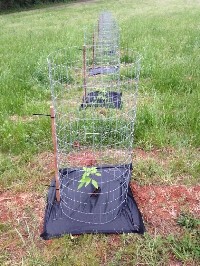|
The American chestnut is not an endangered species, or threatened with extinction. There are millions of small, young chestnut sprouts. Above the site where the tree has been girdled by the fungus, an American chestnut will die. Below the infection site, the chestnut tree’s roots usually survive, so the roots can resprout. A young chestnut tree matures until a crack in the bark allows a new infection, and the cycle repeats itself - which is why we still see small chestnuts growing in Virginia forests.
Today the chestnut is a minor component of the understory, no longer a dominant species that affects the surrounding forest.
|
|
Restoring the Mighty Giants
For many years scientists have been searching for ways to bring back the American chestnut, which has such a storied history and important part of everyday life for millions of people almost a century ago. Three different options are currently being pursued:
· Finding the few naturally-resistant trees still surviving in the woods, with American chestnut genes, then growing new stock from their nuts and grafts to ensure the resistance is transmitted to future generations.
· Using the latest laboratory techniques to insert blight-resistant genes, developing a genetically-modified organism.
· Breeding a blight-resistant hybrid tree, mixing genes of the Chinese chestnut species with the American chestnut.
The cross breeding technique currently has shown much progress and promise in developing a blight resistant American chestnut tree.
Breeding an American/Chinese Hybrid
In 1983 a determined group of plant scientists joined together to form The American Chestnut Foundation (TACF), with the goal of restoring the American chestnut to the eastern forests. Much of the work takes place at their Meadowview research farm, near Abingdon, Virginia.
Seven generations of chestnuts have been raised since the 1980s. Volunteers and staff working for the Foundation climb mature trees, to gather the male pollen from specific trees and bag female flowers to isolate them from wild pollen. The volunteers go back up again to pollinate the female flowers with pollen from specific desired father trees, so the tree will grow a nut with genes from pre-determined parents. After a summer of growth, the nuts are harvested by volunteers/staff who go up the tree a third time. By interbreeding (backcrossing) offspring with various American chestnut parents, TACF has produced a final genome that is 15/16ths American and 1/16th Chinese, including the all-important genes for blight resistance from the Chinese ancestors but showing other characteristics (such as height at maturity) from the American ancestors.
Current plans are to establish numerous stands of “new” chestnuts throughout the Appalachians, by planting trees in test plots which are carefully planned and tracked.
Male Flower Female Flower Bagged Female Flower
Smith Mountain Lake State Park
Brian Heft, Park Manager, Smith Mountain Lake State Park said he learned of the TACFs efforts to reestablish the American chestnut in our area from District Resource Specialist Reed Stanley. They looked at park sites and found one that had the soil type and other factors making it a good location for testing the new strain of American chestnut. He offered the site in the hope that the tree could be established in the park and ultimately provide an abundant supply of chestnuts for wildlife. “Some site preparation is under way, removing stumps and grading. It will be ready for planting in the spring,” he said. The Friends of Smith Mountain Lake State Park and Master Naturalists will be helping with the planting.
Matt Brinkman, Mid-Atlantic Regional Science Coordinator, The American Chestnut Foundation, who is overseeing the planting project said, “There will be about 400 seedlings available for planting. They are the most advanced strain available which is 15/16 American chestnut and 1/16 Chinese chestnut.” Brinkman said that the seedlings will be bare root and have cages to prevent browsing. The nuts producing the plants were harvested at the American Chestnut Foundation’s Meadowview research farm. The seedlings were grown at the Virginia Department of Forestry Center near Charlottesville. He said that the plants all contain different parentage with slightly different levels of resistance. Overall, the average resistance of all those lines and parents is moderate. Brinkman said that as they identify weak parents over the next 5-10 years through analyzing test plantings of their children (the generation at SML) they should be able to increase the overall average resistance. He said that he hopes this planting site, which is the first in a Virginia State Park, will give the managers and local volunteers some experience with American chestnut restoration techniques which sets the stage for larger, more successful projects in the future. Secondly, it serves as a place where individuals, students, etc. can go to see American chestnuts and learn about their historical importance.

Caged American chestnut seedling
Many scientists feel that we have started to pull the American chestnut back from the brink of extinction. Although it will likely be several decades before large quantities of American chestnuts once again populate our eastern forests, the future is beginning to look much brighter for “The Mighty Giant.”
Resources
Photographs obtained from The American Chestnut Foundation
The American Chestnut Foundation
Chestnuts in Virginia; virginiaplaces.org
American Chestnut Restoration Project; The Return of the American Chestnut, Compass, July 2008, U.S. Forest Service
Pursuing an American Dream, Virginia Wildlife, Virginia Department of Game & Inland Fisheries
Forestry in Virginia, Department of Conservation & Recreation
For more information on the Friends of Smith Mountain Lake State Park, go to www.smlspfriends.com.

